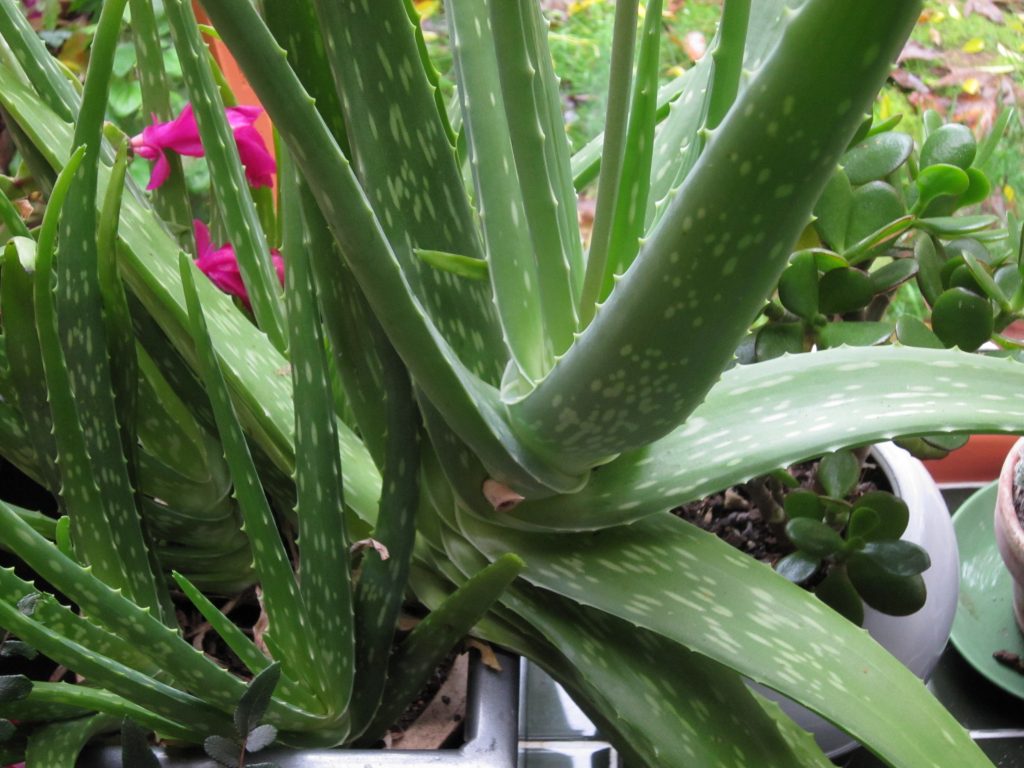Aloe vera is a bit like the homeopathic remedy arnica. Everyone has heard of it, or has used it at some point and like arnica it never fails to deliver. This sadly is where most of us stop, using aloe only for sunburn. Well surprise surprise, this easy to grow plant is so full of active ingredients and healing abilities not to mention vitamins and minerals, I don’t know where to start! I didn’t realise until researching beyond the obvious skin healing and gastric soothing applications how amazing aloe vera actually is. When you think of the places and climates that it hails from, the sort of solar extremes that it survives and thrives in it is no wonder it can be used for treating radiation burns. Not just as an external treatment but used internally as well. It has been shown to have anti-tumour activities, its an immuno-enhancer and is being used for people with HIV aids. Get the picture! It is quite literally a super medicine plant. I have a few strong and healthy plants that live in my bay window. Today I went out and rescued all of my scraggly neglected plants from outside and brought them in and cleaned them up. They are going to be cared for now and I am going to start including some fresh aloe gel in my daily smoothie. You simply snip a leaf off the plant, slice it down the length of the leaf and cut out the inner gel. I’ll start with a small piece and slowly increase my intake.

The thriving plants in my bay window.
Family; Xanthorrhoeaceae. The main varieties used medicinally are aloe chinensis and aloe vera.
Common names; true aloe, first aid plant, indian aloe, chinese aloe, barbados aloe, burn aloe.
Description; aloe is an erect stemless perennial with a thick fibrous root. The leaves are long, thick, fleshy and spear-like. They encircle a thick central trunk and are produced at the centre of the plant. The leaves are grey-green in colour sometimes flecked with white on the upper and lower surfaces. They are edged with sharp tooth like serrations. New plants often called pups are produced at the base of the parent plant. Pups present their leaves in a fan shape until they grow to maturity. Flower stalks develop from the centre of a mature plant (usually 2-3 years). These are produced on a single upright spike which can reach a height of about 35inches. The flowers are poker-like, between 2-3 inches long, and are made up of many pendulous tubular flowers. These change from greenish to yellow/orange as they mature.
Parts used; inner gel.
Preparations; dried & used in tablets and capsules, homeopathic preparations, sprays, juices and drinks, creams, lotions, extracts, soaps, fresh cut leaf, added to tissues, shampoos and cosmetics.
Habitat; aloes are indigenous to East and South Africa, but have been introduced to the West Indies, Southern Texas and Mexico (where they are cultivated for commercial enterprise). The plants will thrive anywhere in containers as long is they have a sunny spot and protection from frosts, snow and waterlogging. They prefer hot and dry climates.
Traditional and historical uses; aloe has been used traditionally for many thousands of years. The ancient Egyptians used the aloe plant for treating infections, skin problems and as a laxative. In the first century AD the Greek physician Dioscorides wrote in his Materia Medica of the use of aloe by the Roman army. It was used for treating burns and wounds, upset stomachs, diarrhoea, constipation, haemorrhoids, headaches and kidney problems. Alexander the Great also used aloe to treat the battle wounds of his soldiers. It spread throughout the old world and has been used by the Chinese, Russians and in India. The Spanish Explorers took plants with them where it was used by some of the North American Indian tribes. The indigenous people of Africa have used aloe since ancient times.
Therapeutic actions; anti-bacterial, anti-viral, anti-fungal, astringent, analgesic, immuno-enhancer, antitumour read more here, anti-inflammatory, coagulant, antibiotic, antioxidant, demulcent, emollient, anti-pruritic, vulnerary, vermifuge, cholagogue, diuretic.
Constituents; polysaccharides including; glucomannin, acemannan and mannan. Essential and non-essential amino acids including; isoleucine, lysine, methionine, phenylalanine, threonine, valine, trytophan, alanine, arginine, cysteine, glutamic acid and histidine. Enzymes including; amylase, bradykinase, catalase, cellulase, lipase. Vitamins A.C &E. B1.B2,B3,B5,B6 and B12. Minerals including; calcium, choline, magnesium, zinc, manganese, chromium, selenium, copper, iron, potassium, phosphorus, and sodium. Trace minerals rhodium and iridium. Glycoproteins. Anthraquinones including; aloin and emodin. Lignins, salicylic acid, prostaglandins, tannins, lectins. Aloins; barbaloin, and isobarbaloin. Sterols and saponins.
Medical uses; amazingly there are hundreds of active constituents in aloe vera. The way modern medicine operates currently is to isolate one active ingredient, test it in clinical trials and if successful, patent and create a prescription drug. Hypercin from St John’s wort is a case in point. The polysaccharide acemannan has been isolated and transformed into ‘carrisyn’. It has shown in clinical trials to be an immuno-enhancer and can be helpful for people with HIV aids. Studies listed here
Current Herbal uses; Externally; sunburn, burns and scalds, read more here radiation burns, wounds, herpes eruptions, psoriasis and rheumatic joint pain. Internally; irritable bowel syndrome, crohn’s disease, colon polyps, coeliac disease, stomach ulcers, acid reflux, digestive disorders, colon cancer read more here, constipation, candidiasis, mouth ulcers, gum disease, kidney disease, to stabilize blood sugar levels in diabetics, joint inflammation and arthritic pain,?high blood pressure, oxygenates the blood, ‘sludge blood’ and ‘sticky blood’,?high cholesterol read more here, burns and scalds, radiation burns, dry damaged skin.
Food uses; energy drinks, health drinks.
Naturally by Trisha products containing aloe vera; Everyday Balm, Pile it On, Baby Bottom Balm,
I like the way you organize all the facts about a plant. My aunt started using aloe vera, drinking a small amount of juice every day, aboout 30 years ago. She’s 93.